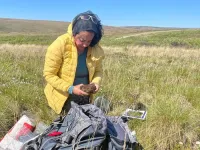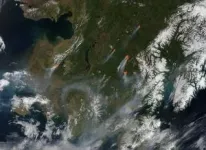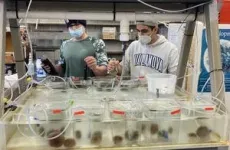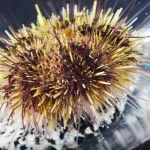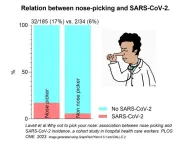(Press-News.org) Wildfires are an ancient force shaping the environment, but they have grown in frequency, range and intensity in response to a changing climate. At the Department of Energy’s Oak Ridge National Laboratory, scientists are working on several fronts to better understand and predict these events and what they mean for the carbon cycle and biodiversity.
Two months into the 2023 peak summer fire season from June through August, Canadian wildfires had burned more than 25 million acres of land, disrupted the lives of millions and spread beyond the traditional confines of western Canada east to Nova Scotia. The phenomenon attracted renewed attention as smoke drifted to heavily populated regions, turning the New York City skyline orange and drifting across the Atlantic Ocean to Europe by late June.
Understanding the many risks and impacts of wildfires is at the heart of several projects at ORNL. Henriette “Yetta” Jager, an ORNL scientist whose research sits at the intersection of energy and ecology, has studied how selective forest thinning can both remove fuel for wildfires and provide plant material for conversion into biofuels.
“It’s a complex topic,” Jager said. “The science is showing that although it may be difficult to remove undergrowth and thin trees in some roadless areas, simply leaving old growth forest alone may cause more harm than good. For at-risk species such as spotted owls, letting fuel build up can cause larger and more widespread fires that can be worse in the long run.”
Jager has worked with colleagues to build a framework that can support decision-making around forest-thinning practices, landscape patterns and even spatial firefighting tactics. Results of their work could be used to protect terrestrial and aquatic species that need safe passage to move away from wildfire and then return later.
“Wildfire disturbance is a part of nature, and species are adapted to it, but we’re in a different situation now with climate change,” Jager said. “There are going to be big shifts in when these fires happen, their size and severity, which will cause big shifts in vegetation and new impacts on animal species.
“By continuing our research, we can help forest managers plan for these shifts.”
Unearthing data in the carbon-rich Arctic tundra
Advancing the understanding of wildfire effects on the carbon cycle is a focus for ORNL scientist Fernanda Santos. She studies not only single events, but also repeated wildfires over decades. She examines what these fires portend for the land’s ability to lock away carbon. And, conversely, her work evaluates how fires can become a source of carbon emissions during wildfires and potentially intensify the warming cycle. The world’s soils hold more than 3 gigatons of carbon — triple the amount in the atmosphere — and roughly 70% of the top layer of all soils has been exposed to fire at some point.
Her research illuminates the anticipated changes as the land evolves in response to fire. “A lot of people think of evolution as something that happens over centuries,” Santos said. “But the idea of rapid evolution, including how plants and soil microbiomes rapidly adapt to increased fires, is relatively new. Will we see more or less biodiversity after repeated fires? Ultimately, we want to know how fire affects these environments, including belowground.”
Fire affects plant functional traits as well as the diversity and function of microbes and other organisms in and around the soil that can alter plant and soil quality, Fernanda and colleagues said in a special issue of Functional Ecology examining knowledge gaps in the study of wildfire evolutionary impacts. Changes in wildfire regimes related to a hotter climate, like greater recurrence and severity, have been reported to accelerate the transition from tree- to shrub-dominated ecosystems, for instance. Fire’s evolutionary influence can be seen in the selection of plants with traits such as thicker bark and fast germination and resprouting and can result in less plant diversity.
The scientists also pointed to the need for more research into how fire may affect plant-fungal interactions in forests. More severe and repeated wildfire may also impact the sensory cues that animals, including insects, pollinators and herbivores, typically use to avoid fire and result in additional implications for biodiversity in a changing climate, the scientists said.
At ORNL, Santos works on projects like the DOE Next-Generation Ecosystem Experiments Arctic, or NGEE Arctic, performing experiments and collecting observational data to better understand changes happening in Arctic ecosystems. She concentrates on disturbance ecology — what events such as wildfires and pest outbreaks mean for the environment and future climate feedbacks. She examines the organic and inorganic chemistry of the Arctic topsoil, which helps insulate the tundra’s carbon-rich permafrost layer.
Refining large-scale climate simulations
Santos is also helping refine large-scale simulations of the Earth’s climate, such as DOE’s Energy Exascale Earth System Model, to better represent different forms of carbon like charred biomass — soot and charcoal — that result from wildfire. E3SM is supported by the DOE Office of Science’s Biological and Environmental Research Program and spans eight national labs, including ORNL. The model runs on the world’s fastest supercomputers, providing highly advanced simulations to better predict environmental change that could affect the energy sector.
All of that work depends on the quality and quantity of observational and experimental data. To enhance wildfire- related datasets, Santos and ORNL colleague Jiafu Mao have launched a Fire Community Database Network to encourage scientists and land managers to submit environmental data on burned areas to a central repository. Sharing such information can not only improve research, but also inform land management practices, the scientists said.
Wildfires consume not only the biomass of plants and trees, but can also result in the release of carbon that has been stored in soils for years or centuries, Santos said. “Our work in the Arctic is focused on a better understanding of what may happen in these carbon-rich soils in higher latitudes like Alaska and Canada. We model and predict the land carbon cycle, and I’m focused on helping decrease the uncertainty in those models with field data about historical fires.”
More detail on ORNL’s modeling and simulation work around wildfire is available in this recent article.
Support for the projects comes from the DOE BER program, the DOE Office of Energy Efficiency & Renewable Energy’s Bioenergy Technologies Office, and ORNL Laboratory Directed Research and Development.
UT-Battelle manages ORNL for DOE’s Office of Science, the single largest supporter of basic research in the physical sciences in the United States. The Office of Science is working to address some of the most pressing challenges of our time. For more information, please visit energy.gov/science.
END
Scientists dig into wildfire predictions, long-term impacts
2023-08-02
ELSE PRESS RELEASES FROM THIS DATE:
Sea urchins are struggling to ‘get a grip’ as climate change alters ecosystems
2023-08-02
When driving through a rainstorm, traction is key. If your tires lack sufficient tread, your vehicle will slip and slide and you won’t have the grip needed to maneuver safely. When torrential rains hit nearshore, shallow water ecosystems, sea urchins experience a similar challenge. Heavy precipitation can alter the concentration of salt in the ocean waters causing lower salinity levels. Even a slight change in salinity can affect the ability of sea urchins to securely attach their tube feet to their surroundings – like tires gripping the road. This ...
When D turns to F, quantum matter is A-plus
2023-08-02
HOUSTON – (Aug. 2, 2023) – Rice University physicists have shown that immutable topological states, which are highly sought for quantum computing, can be entangled with other, manipulable quantum states in some materials.
“The surprising thing we found is that in a particular kind of crystal lattice, where electrons become stuck, the strongly coupled behavior of electrons in d atomic orbitals actually act like the f orbital systems of some heavy fermions,” said Qimiao Si, co-author of a study about the research in Science Advances.
The unexpected find provides ...
A novel strategy to suppress triple negative breast cancer growth
2023-08-02
In 2022, a team of researchers at Baylor College of Medicine discovered that a little-known enzyme called MAPK4 is involved in the growth of triple negative breast cancer (TNBC) and its resistance to certain therapies. Looking into the details of this novel role of MAPK4, the researchers have now identified a strategy that can potentially control MAPK4-promoted growth in TNBC and other cancers. The study, published in PLOS Biology, opens new options for treating this devastating disease.
“Some cancers depend on MAPK4 for their growth, and our team studies cellular processes or pathways that participate in ...
Super Radar: Breakthrough radar research overcomes a nearly century-old trade-off between wavelength and distance resolution
2023-08-02
New interference radar functions employed by a team of researchers from Chapman University and other institutions improve the distance resolution between objects using radar waves. The results may have important ramifications in military, construction, archaeology, mineralogy and many other domains of radar applications.
This first proof-of-principle experiment opens a new area of research with many possible applications that can be disruptive to the multi-billion dollar radar industry. There are many new avenues to pursue both in theory and experiment.
The ...
Study finds Black people less likely to be seen at memory clinic than white people
2023-08-02
MINNEAPOLIS – Black people and people living in less affluent neighborhoods—areas with higher poverty levels and fewer educational and employment opportunities— may be less likely to be seen at a memory care clinic compared to white people and people living in neighborhoods with fewer disadvantages, according to new research published in the August 2, 2023, online issue of Neurology®, the medical journal of the American Academy of Neurology.
“Our results are concerning, especially ...
Bullying, suicidal thoughts linked to more frequent headaches in teens
2023-08-02
MINNEAPOLIS – Teens who have been bullied by their peers, or who have considered or attempted suicide, may be more likely to have more frequent headaches than teens who have not experienced any of these problems, according to a study published in the August 2, 2023, online issue of Neurology®, the medical journal of the American Academy of Neurology. The study does not prove that bullying or thoughts of suicide cause headaches; it only shows an association.
“Headaches are a common problem for teenagers, but our study looked beyond the biological factors to also consider the psychological and social factors that are associated with headaches,” ...
Study defines disparities in memory care
2023-08-02
Patients who live in less affluent neighborhoods and those from underrepresented racial or ethnic groups are less likely than others to receive specialized care for dementia, including Alzheimer’s disease, a new study from Washington University School of Medicine in St. Louis indicates. Further, the research shows that Black people are more likely than white people to be diagnosed with dementia at a later, more advanced stage, which could contribute to inequities in access to new treatments.
The study appears Aug. 2 in the journal Neurology.
New medications ...
New analysis shows surgery is safe and effective for people with unruptured brain arteriovenous malformation
2023-08-02
CONTACT: Camille Jewell
cjewell@vancomm.com or 202-248-5460
SAN DIEGO—Contrary to the results of a seminal study in the field, a recent analysis presented today at the Society of NeuroInterventional Surgery’s (SNIS) 20th Annual Meeting indicates that surgical approaches (embolization, microsurgery, radiosurgery) for treating selected patients with unruptured arteriovenous malformation (AVM) is safe and effective.
AVMs are tangled blood vessels with abnormal connection between arteries and veins, bypassing the capillary ...
Researchers develop smartphone app that reliably recognizes physical signs of stroke
2023-08-02
CONTACT: Camille Jewell
cjewell@vancomm.com or 202-248-5460
SAN DIEGO—Today at the Society of NeuroInterventional Surgery’s (SNIS) 20th Annual Meeting, researchers discussed a smartphone app created that reliably recognizes patients’ physical signs of stroke with the power of machine learning.
In the study, “Smartphone-Enabled Machine Learning Algorithms for Autonomous Stroke Detection,” researchers from the UCLA David Geffen School of Medicine and multiple medical institutions in Bulgaria used data from 240 patients with stroke at four metropolitan stroke centers. Within 72 hours of the ...
Nose-picking healthcare workers were more likely to catch COVID-19 during the pandemic than their colleagues who refrained, per Netherlands cohort study
2023-08-02
Nose-picking healthcare workers were more likely to catch COVID-19 during the pandemic than their colleagues who refrained, per Netherlands cohort study
###
Article URL: https://journals.plos.org/plosone/article?id=10.1371/journal.pone.0288352
Article Title: Why not to pick your nose: Association between nose picking and SARS-CoV-2 incidence, a cohort study in hospital health care workers
Author Countries: The Netherlands
Funding: This work was funded by the Netherlands Organization for Health Research and Development ZonMw (S3 study, grant agreement no. 10430022010023 to M.K.B.) and the Corona ...
